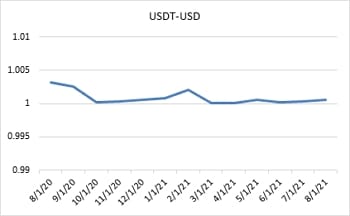Part One In a Three Part Series On Digital Currency
You likely already know that Bitcoin is a form of digital currency experiencing major growth. But, have you heard about Tether? Did you ever consider your debit card as a form of digital currency? Cryptocurrencies are not the finance industry’s first foray into the digital space. In fact, digital money has existed for a long time, and it is continuing to evolve.
In this first post of a three-part series, let’s explore four different types of digital currencies to better understand the role they are playing in our global economy.
1. Bank Deposits
If you’ve ever owned a debit card, you’ve used digital currency. Only about 10% of the money deposited by people in banks is kept in physical cash. The rest of the deposits are processed and transferred as necessary via a digital payments system, such as a debit card or electronic funds transfer. Although there is no exchange of physical dollars, electronic payments still utilize legal tender, backed by the federal reserve.
2. Cryptocurrency
On the other end of the digital currency spectrum is cryptocurrency. Cryptocurrencies exist solely on a digital infrastructure known as a blockchain, and they are not backed by any sort of physical currency reserve. While bank deposits are known for their reliability, cryptocurrency has gained a reputation for volatility. Because cryptocurrencies are decentralized, they lack the stability that comes with healthy amounts of regulation and oversight. High-value coins like Bitcoin and Ethereum have become known for their volatility, which could lead to massive gains or equally great losses.
In the first half of 2021, Bitcoin’s trading volume saw 489% growth compared to the previous year. Ethereum, the second largest cryptocurrency, saw trading volumes rise 1,461% over the same period. Despite the immense skepticism that surrounds crypto, digital coins have cemented themselves as important parts of the global financial system.
3. Stablecoin
Stablecoins are similar to cryptocurrency in that they exist solely on a digital infrastructure. However, unlike cryptocurrencies, stablecoins are tied to the value of some other assets via reserves, making them less volatile than traditional cryptocurrencies. Tether (USDT), a stablecoin that is backed by U.S. dollar reserves, has historically remained within 0.5% of the dollar’s value.

Source: Blue Chip Partners, with Data from Bloomberg. Data as of Aug. 16, 2020
4. Central Bank Digital Currency
Like stable coins, Central Bank Digital Currency (CBDC) combines the advantages of crypto with the stability of fiat currency. However, CBDC is not the same as a stable coin, because CBDC is directly backed and issued by the Federal Reserve. In most countries, CBDC is being explored or developed, but is yet to be actively used. That said, it is being pursued by central banks around the world, as they believe it will bring about efficient economics, financial inclusion, and high security. Countries are devoting immense resources into researching CBDC.
Check out for part two of our series to learn how CBDC development has progressed in the U.S. and around the world.
Read more about Digital Currency here.
Expressions of opinion are as of this date and are subject to change without notice. The information provided does not constitute tax, legal, accounting, or other professional advice and is without warranty as to the accuracy or completeness of the information. Any information provided is not a complete summary or statement of all available data necessary for making an investment decision and does not constitute a recommendation to buy, hold or sell any security. The information has been obtained from sources considered to be reliable, but we do not guarantee that the foregoing material is accurate or complete. There are limitations associated with the use of any method of securities analysis. Indices are included for informational purposes only; investors cannot invest directly in any index. Every investor’s situation is unique, and you should consider your investment goals, risk tolerance and time horizon before making any investment. Prior to making an investment decision, please consult with your financial advisor about your individual situation. Past performance does not guarantee future results. Investing involves risk and you may incur a profit or loss regardless of strategy selected. There is no guarantee that any statements, opinions or forecasts provided herein will prove to be correct.

